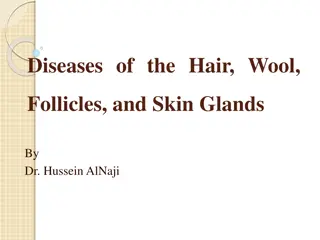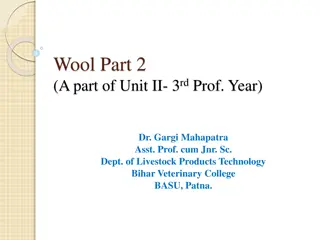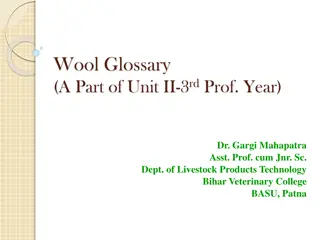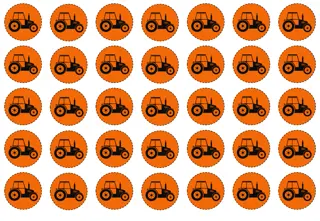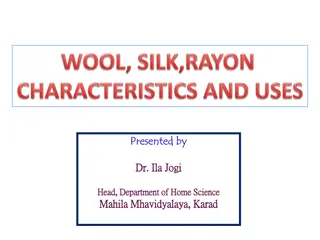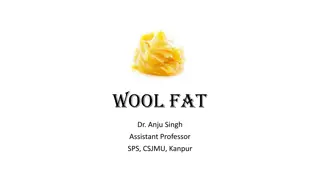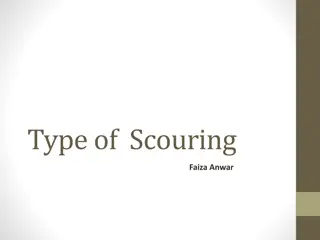Understanding the Physical Structure of Wool Fiber
Wool is a natural protein fiber with a unique structure composed of a cortex and cuticle, lacking a medulla. Its physical structure includes the cuticle as the outer protective layer, cortex with corticular cells, cell membrane complex, macro-fibrils, matrix, micro-fibrils, and helical coils. The structure provides wool with its characteristics like elasticity, hygroscopic nature, and resilience. Mohair, a type of fur/hair from Angora goats, is also described for its similarities and differences to wool.
Download Presentation

Please find below an Image/Link to download the presentation.
The content on the website is provided AS IS for your information and personal use only. It may not be sold, licensed, or shared on other websites without obtaining consent from the author. Download presentation by click this link. If you encounter any issues during the download, it is possible that the publisher has removed the file from their server.
E N D
Presentation Transcript
Wool Part 1 (A part of Unit II- 3rdProf. Year) Dr. Gargi Mahapatra Asst. Prof. cum Jnr. Sc. Dept. of Livestock Products Technology Bihar Veterinary College BASU, Patna.
Wool is a natural fibre of animal origin which is hygroscopic in nature, is crimpled, elastic and grows in clusters. It s a fibre of cylindrical structure and basically protein in nature. Structurally it consists of a cortex and cuticle, it is devoid of a medulla. WOOL
Mohair Fur/ Hair A synonym for non-human hair. The term is sometimes used to refer to the body hair of animal as a complete coat, also known as pelage. Structurally it is similar to hair and it consists of cuticle, cortex and medulla. Natural fibre obtained from Angoora goats. Has approx. 25-45 microns diameter and is both resilient and durable. It is notable for its high lustre and sheen, mohair has scales as wool but the scales are not fully developed, hence it doesn t felt like wool. Like wool mohair has no medulla Allied Fibres Allied Fibres
PHYSICAL STRUCTURE OF WOOL A protein fibre made up of keratin. It contains sulphur containing amino acid, cysteine.
Physical Structure of Wool cont. Cuticle: Outer most protective layer of scales. The scales overlap each other like tiles, exposed edges faced outwards. It has a waxy coating which makes it resistant to water and water based stains. Cortex: Internal cells of the fibre, contributes 90% of the fibre. Cortex contains corticular cells and cell membrane complex. Contains two types of cells ortho-corticle cells para-corticle cells Cell Membrane Complex: It contains proteins and waxy lipids which runs through out the whole fibre. The molecules in this region has fairly weak intermolecular bonds which breaks downs easily when exposed to harsh handling and strong chemicals.
Physical Structure of Wool cont. Macro-fibrils: Long rod like filaments present inside the cortical cells. Matrix: It is a continuous phase having micro-fibrils embedded in it. It consists of sulphur containing proteins. The matrix is the region responsible for wool s fire resistance and anti-static property. Micro-fibrils: They are the basic supporting system of the wool fibre. It gives strength and flexibility to the fibre. They contain pairs of twisted molecular chains. Helical coil: It is the smallest part of the fiber. It consists of twisted molecular(protein) chains that are coiled in helical shape. This structure is stiffened by hydrogen and di-sulphide bonds. These bonds link each coil of the helix helping to prevent stretching,
Cuticular Patterns Coronal Corona-Reticulate Reticulate Each scale forms Ring around the fibre is made Scales arranged in a complete ring from more than 1 scale. The an irregular network around the fibre. lateral and axial band overlap above the fibre Top portion of 1 top of 1 scale overlaps the bottom surface. scale overlaps portion of the next. bottom portion of the next.
CHEMICAL STRUCTURE OF WOOL Long chains of keratin roughly lie parallel to the long axis of the fiber. Long keratin molecules linked together in 3 different ways Cysteine links Ionic links Hydrogen bonds
Physical Properties Physical Properties Chemical Properties Chemical Properties Wool burns slowly and forms a porous brittle mass of carbon. Gives up moisture when heated up to 100-150 C. When heated to a temp. of 130 C, keratin readily decomposes to ammonia. Insoluble in water. Continuous boiling of wool causes breakage of its macromolecules, causing decomposition. Wool softens on soaking in cold water Cylindrical in structure. Devoid of medulla. Shows curliness/ crimpiness (2- 12/cm) Durable. Elastic, stretches up-to 30% of its normal length. Hygroscopic, absorbs 18-50% of its own weight. Light weight; Water-proof, Non- inflammable and light weighted. Properties of Wool Properties of Wool
Physical Properties Physical Properties Chemical Properties Chemical Properties No harm occurs to wool, when exposed to cold or boiling solutions of mineral acids. Colour of wool becomes light yellow on treating with nitric acid, this colour reaction is useful in identifying animal fibre. Slow dissolution of wool occurs in concentrated mineral acids. Wool is sensitive to alkalis. Complete destruction and dissolution of wool occurs when boiled with 5% solution of caustic soda. Transmits UV rays. Strong, stronger than steel of the same diameter. Can be felted or matted easily. Shrinks when subjected to wash in warm water containing mild soap. Wool fiber has projections which help in adherence. Specific gravity- 1.304 & Refractive index varies between 1.553-5.00. Exposed to cold water wool fiber diameter is seen to increase. Properties of Wool Properties of Wool contd.. contd..
WOOL QUALITY WOOL QUALITY Parametres Fibre-fineness Fibre length and Staple length Moisture Content Crimp Frequency Medullation Percentage Scouring Yield Burr Content Colour Lustre 1. 2. 3. 4. 5. 6. 7. 8. 9.
Moisture content and Moisture Regain Moisture = Mass of absorbed water in specimen X 100 Regain % Mass of dry specimen Moisture = Mass of absorbed water in specimen X 100 Content % Mass of undried specimen
Length Expressed in centimetres. Determines spinnability of the fibre Fibre Length- Length of the fibre in straightened condition. Staple - Length of the fibre in relaxed condition Length (with crimps) Crimp Number of crimps per unit length of the frequency fibre
Volume occupied by medulla in a fibre. Expressed in percentage (%). Varies from 5%-89%-99% Medullated fibres are of lower density. They are stiff and less elastic. Evaluated using- Projection microscope, Lanometre and Dichlorobenzene. MEDULLATION PERCENTAGE
The process of cleaning of wool is called scouring. Scouring detergent @ 0.3-0.6% is added to water at 45 C. Scouring is practiced by dipping the wool in bowls containing scouring solution and the process should be repeated at least twice. SCOURING YIELD
BURR CONTENT Amount of vegetable content present in a fleece is known as burr content. It is estimated by dissolving wool in NaOH solution. Types Low Burr 3% Medium Burr 5% Heavy Burr >5% The process of removal of burr is known as Carbonization.
Thank Thank You You





